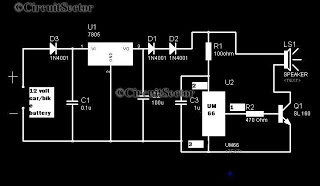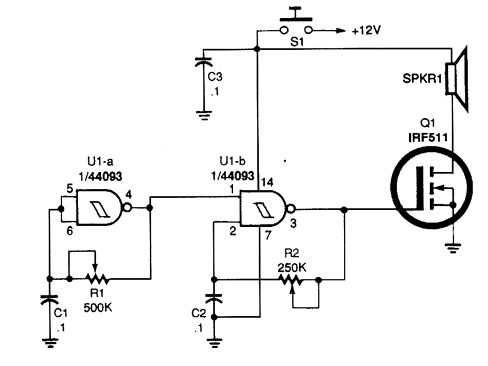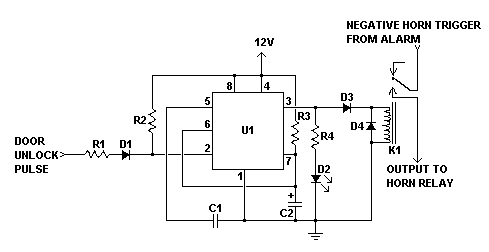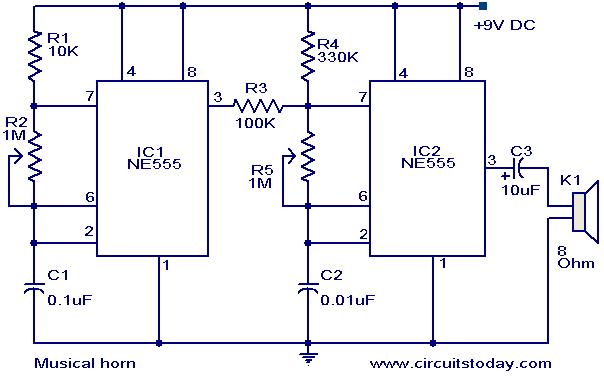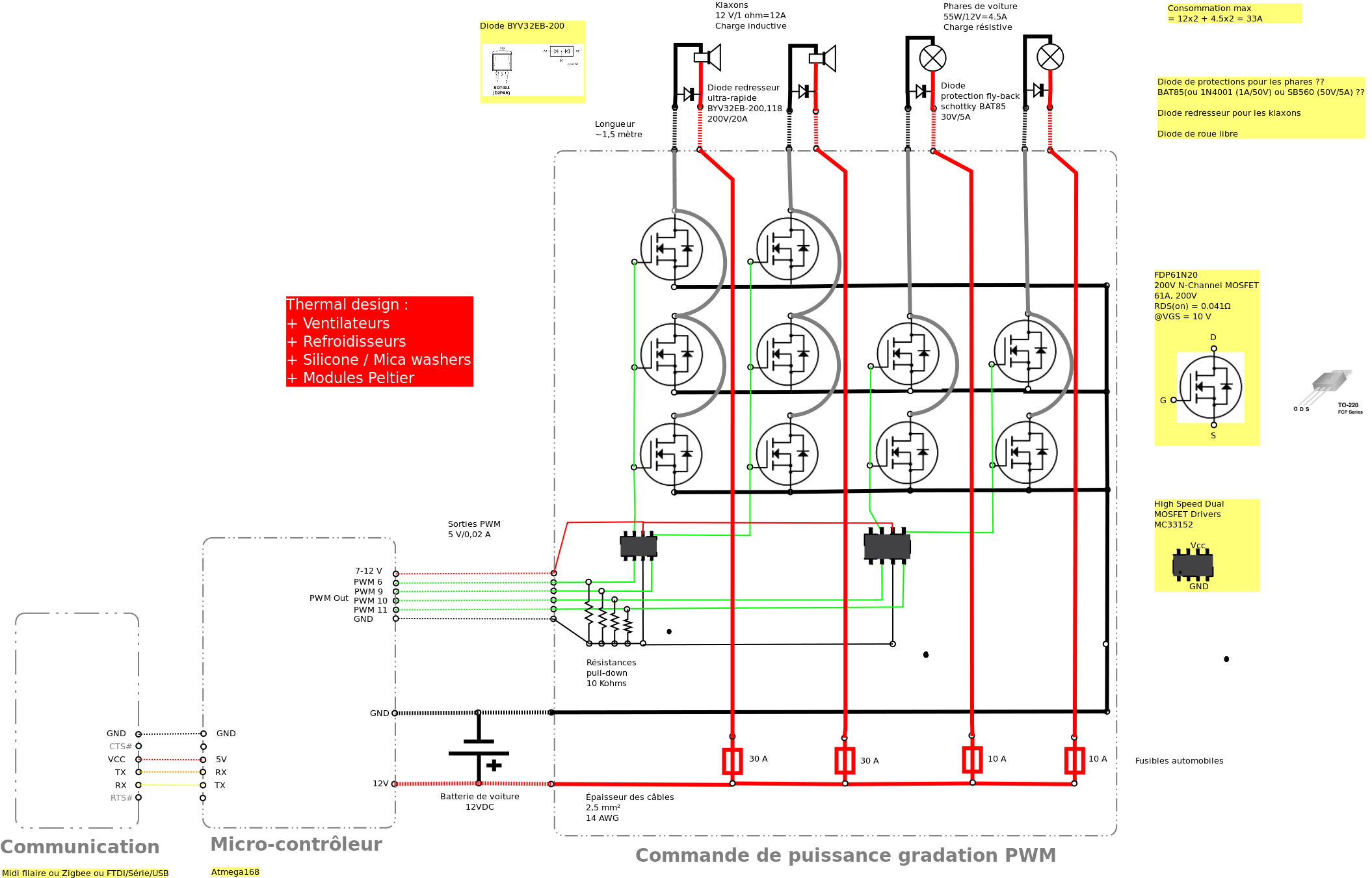
Bull horn
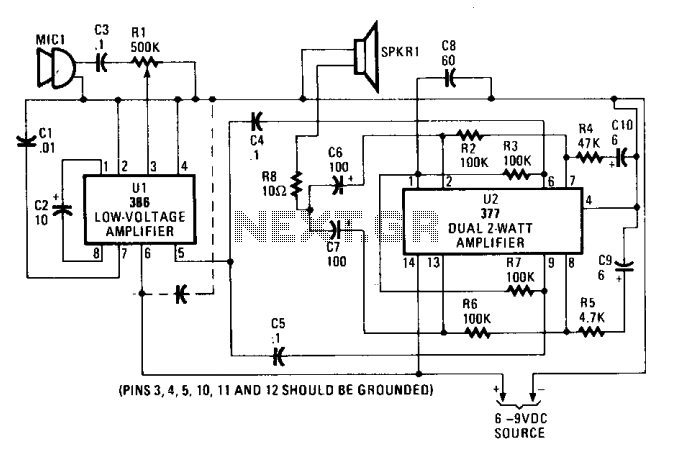
The input audio signal is connected to pin 3 of U1, an LM386 low-voltage amplifier, through capacitor C3 and resistor R1. The potentiometer R1 adjusts the drive or volume level. U1 functions as a driver stage, with a gain that can be configured between 20 and 200. The output from U1 at pin 5 is directed to U2, a 377 dual two-watt amplifier, which is configured in parallel to deliver approximately four watts of output power at pins 6 and 9 via capacitors C4 and C5. Frequency stability is maintained by resistors R2, R4, and capacitor C10 on one side, along with the corresponding components R6, R5, and C9 on the other side. The outputs of the two amplifiers (located at pins 2 and 13) are capacitively coupled to the speaker SPKR1 through capacitors C6 and C7.
The circuit comprises a low-voltage audio amplification system utilizing an LM386 amplifier (U1) as the initial amplification stage. The input audio signal is processed through capacitor C3, which blocks any DC offset, ensuring that only the AC audio signal passes through to U1. Resistor R1, configured as a potentiometer, allows for adjustable gain control, enabling the user to modify the output volume to their preference.
U1 can be configured for various gain settings, providing flexibility depending on the application requirements. The output from U1 is delivered to a dual amplifier configuration (U2), specifically the 377 model, which is designed to amplify the signal further. This dual amplifier is connected in parallel, effectively doubling the output power to around four watts. The output coupling is achieved through capacitors C4 and C5, which serve to isolate the amplifiers from each other while allowing the audio signal to pass through.
Frequency stability in this circuit is crucial for maintaining sound quality. The stability is achieved through a combination of resistors R2, R4, and capacitor C10 on one side, paired with resistors R6, R5, and capacitor C9 on the opposite side. These components work together to form a feedback network that stabilizes the gain and frequency response of the amplifiers.
Finally, the outputs of both amplifiers are capacitively coupled to the speaker (SPKR1) via capacitors C6 and C7. This coupling ensures that any DC components are blocked, allowing only the amplified AC audio signal to drive the speaker. This design results in an efficient audio amplification system suitable for a variety of low-power audio applications.The input audio signal is fed to pin 3 of Ul, an LM386 low-voltage amplifier, via C3 and Rl. Potentiometer Rl sets the drive or volume level. Ul, which serves as a driver stage, can be set for a gain of from 20 to 200. The output of Ul at pin 5 is fed to U2—a 377 dual two-watt amplifier connected in parallel to produce about four watts of output power—at pins 6 and 9 via C4 and C5. Frequency stability is determined by R2, R4, and CIO on one side, and the corresponding components R6, R5, and C9 on the other side.
The outputs of the two amplifiers (at pins 2 and 13) are capacitively coupled to SPKR1 through C6 and C7. 🔗 External reference
The circuit comprises a low-voltage audio amplification system utilizing an LM386 amplifier (U1) as the initial amplification stage. The input audio signal is processed through capacitor C3, which blocks any DC offset, ensuring that only the AC audio signal passes through to U1. Resistor R1, configured as a potentiometer, allows for adjustable gain control, enabling the user to modify the output volume to their preference.
U1 can be configured for various gain settings, providing flexibility depending on the application requirements. The output from U1 is delivered to a dual amplifier configuration (U2), specifically the 377 model, which is designed to amplify the signal further. This dual amplifier is connected in parallel, effectively doubling the output power to around four watts. The output coupling is achieved through capacitors C4 and C5, which serve to isolate the amplifiers from each other while allowing the audio signal to pass through.
Frequency stability in this circuit is crucial for maintaining sound quality. The stability is achieved through a combination of resistors R2, R4, and capacitor C10 on one side, paired with resistors R6, R5, and capacitor C9 on the opposite side. These components work together to form a feedback network that stabilizes the gain and frequency response of the amplifiers.
Finally, the outputs of both amplifiers are capacitively coupled to the speaker (SPKR1) via capacitors C6 and C7. This coupling ensures that any DC components are blocked, allowing only the amplified AC audio signal to drive the speaker. This design results in an efficient audio amplification system suitable for a variety of low-power audio applications.The input audio signal is fed to pin 3 of Ul, an LM386 low-voltage amplifier, via C3 and Rl. Potentiometer Rl sets the drive or volume level. Ul, which serves as a driver stage, can be set for a gain of from 20 to 200. The output of Ul at pin 5 is fed to U2—a 377 dual two-watt amplifier connected in parallel to produce about four watts of output power—at pins 6 and 9 via C4 and C5. Frequency stability is determined by R2, R4, and CIO on one side, and the corresponding components R6, R5, and C9 on the other side.
The outputs of the two amplifiers (at pins 2 and 13) are capacitively coupled to SPKR1 through C6 and C7. 🔗 External reference

